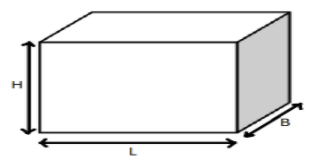
Find the length of the diagonal of the cuboid whose dimensions are:
(i) 2, 3 and 4 cm
(ii) 3, 4 and 5 cm
Answer
537.9k+ views
Hint: Here we will substitute the given dimensions in the formula of the length of the diagonal of the cuboid. Then by simplifying the equation, we will get the lengths of the diagonal of the cuboid. A Cuboid is a three-dimensional shape with six flat surfaces, eight vertices or corners and twelve edges.
Formula used: Diagonal of the cuboid, \[d = \sqrt {{l^2} + {b^2} + {h^2}} \] where, \[l\] is the length of the cuboid, \[b\] is the breadth of the cuboid and \[h\] is the height of the cuboid.
Complete step by step solution:
We will first draw the diagram of a cuboid.

(i) The given dimensions of the cuboid are 2, 3 and 4 cm.
Now by using the formula of the length of the diagonal of the cuboid, we get length of the diagonal of the cuboid as:
\[d = \sqrt {{2^2} + {3^2} + {4^2}} \]
Applying the exponent on the terms, we get
\[ \Rightarrow d = \sqrt {4 + 9 + 16} = \sqrt {29} cm\]
Hence, the length of the diagonal of the cuboid whose dimensions are 2, 3 and 4 cm is equal to \[\sqrt {29} cm\].
(ii) The given dimensions of the cuboid are 3, 4 and 5 cm.
Now by using the formula of the length of the diagonal of the cuboid, we get length of the diagonal of the cuboid as:
\[d = \sqrt {{3^2} + {4^2} + {5^2}} \]
Applying the exponent on the terms, we get
\[ \Rightarrow d = \sqrt {9 + 16 + 25} = \sqrt {50} cm\].
Hence, the length of the diagonal of the cuboid whose dimensions are 2, 3 and 4 cm is equal to \[\sqrt {50} cm\].
Note:
We should not get confused between cube and cuboid. We know that the faces of a cuboid are parallel to each other. Unlike cube, the sides of the cube are not equal. The length of all the edges of the cube is equal to each other but it does not happen in a cuboid. The Cube is the most symmetric in all hexahedron shaped objects. The diagonals of the cube are identical to each other but the diagonals of a cuboid are not equal.
Formula used: Diagonal of the cuboid, \[d = \sqrt {{l^2} + {b^2} + {h^2}} \] where, \[l\] is the length of the cuboid, \[b\] is the breadth of the cuboid and \[h\] is the height of the cuboid.
Complete step by step solution:
We will first draw the diagram of a cuboid.

(i) The given dimensions of the cuboid are 2, 3 and 4 cm.
Now by using the formula of the length of the diagonal of the cuboid, we get length of the diagonal of the cuboid as:
\[d = \sqrt {{2^2} + {3^2} + {4^2}} \]
Applying the exponent on the terms, we get
\[ \Rightarrow d = \sqrt {4 + 9 + 16} = \sqrt {29} cm\]
Hence, the length of the diagonal of the cuboid whose dimensions are 2, 3 and 4 cm is equal to \[\sqrt {29} cm\].
(ii) The given dimensions of the cuboid are 3, 4 and 5 cm.
Now by using the formula of the length of the diagonal of the cuboid, we get length of the diagonal of the cuboid as:
\[d = \sqrt {{3^2} + {4^2} + {5^2}} \]
Applying the exponent on the terms, we get
\[ \Rightarrow d = \sqrt {9 + 16 + 25} = \sqrt {50} cm\].
Hence, the length of the diagonal of the cuboid whose dimensions are 2, 3 and 4 cm is equal to \[\sqrt {50} cm\].
Note:
We should not get confused between cube and cuboid. We know that the faces of a cuboid are parallel to each other. Unlike cube, the sides of the cube are not equal. The length of all the edges of the cube is equal to each other but it does not happen in a cuboid. The Cube is the most symmetric in all hexahedron shaped objects. The diagonals of the cube are identical to each other but the diagonals of a cuboid are not equal.
Recently Updated Pages
Master Class 9 General Knowledge: Engaging Questions & Answers for Success

Master Class 9 English: Engaging Questions & Answers for Success

Master Class 9 Science: Engaging Questions & Answers for Success

Class 9 Question and Answer - Your Ultimate Solutions Guide

Master Class 8 Maths: Engaging Questions & Answers for Success

Class 8 Question and Answer - Your Ultimate Solutions Guide

Trending doubts
Which places in India experience sunrise first and class 9 social science CBSE

Fill the blanks with the suitable prepositions 1 The class 9 english CBSE

Write the 6 fundamental rights of India and explain in detail

Difference Between Plant Cell and Animal Cell

What is pollution? How many types of pollution? Define it

What is the Full Form of ISI and RAW




